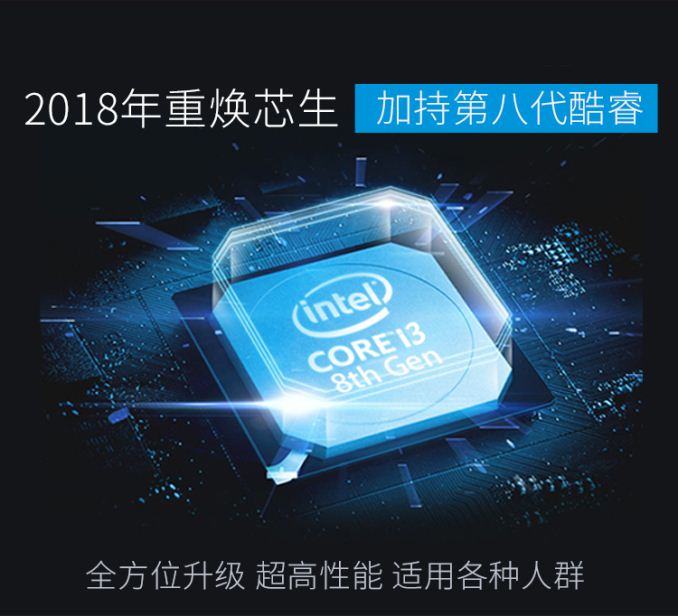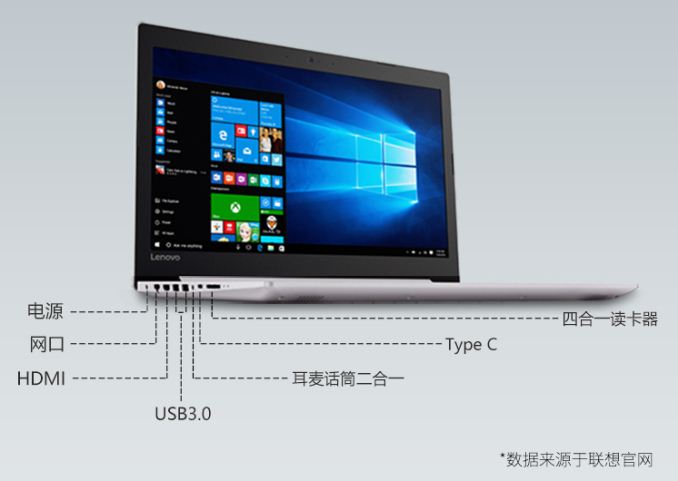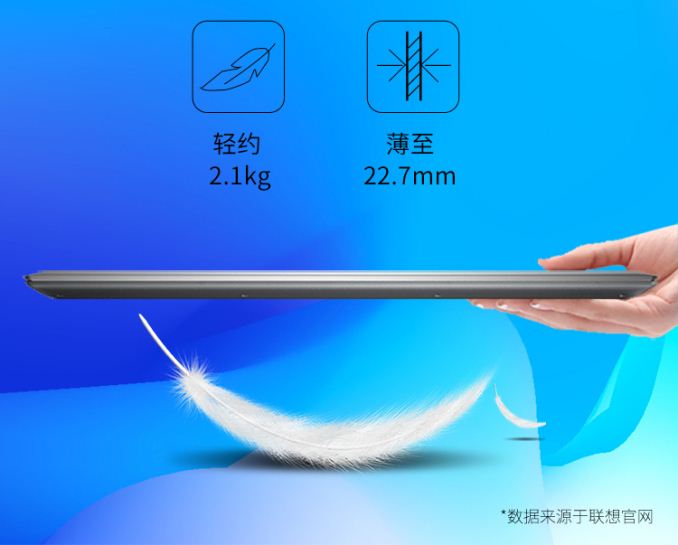First 10nm Cannon Lake Laptop Spotted Online: Lenovo Ideapad 330 for $449
by Ian Cutress on May 13, 2018 11:02 AM EST
In the fruitless efforts to get an answer from Intel as to exactly who is buying their first 10nm processors using the new Cannon Lake microarchitecture, we seem to now have an answer. Lenovo, one of Intel's biggest partners for laptops, has a new Ideapad 330 model available through an official distributor on China's online retailer JD.
The Ideapad 330 is a low end unit in both price and design. The bottom configuration is only 3299CNY, which converts to around $449 pre-tax. This model will feature the new 10nm Core i3-8121, a dual core processor based on Cannon Lake running at a 2.2 GHz base frequency. Pairing with this CPU will be an AMD Radeon RX 540 2GB, as the Intel processor does not have integrated graphics - technically the silicon for them is there, but in this design it is disabled. Our original source, Computerbase.de, states that the processor can turbo up to 3.1 GHz.
The Cannon Lake-based Lenovo Ideapad 330 will be a 15.6-inch laptop, however with a 1366x766 display and a TN panel, both metrics earmarked for low end devices. The stock configuration will be with 4GB of DDR4-2133 memory via a single SO-DIMM module, and a 500GB 5400RPM rotational hard drive for 3299CNY - however the listing on JD.com does offer upgrades up to 8GB of memory, a 1TB spinning drive, and a 256 GB solid state drive, for 3899CNY. The listing does not state which memory configurations are single/dual channel or what brand of storage drives are being used. In actual fact, the images on the listing state DDR4-2133, but the specifications list states DDR4-2400.
The unit will come in at 2.1 kg, and just under an inch thick at 22.7mm. The keyboard offers a full number pad , although it does come with half-height up and down arrow keys. Connectivity on the sides include an expandable gigabit Ethernet port, a HDMI port, two USB 3.0 Type-A ports, a Type-C port (of unknown standard), an SD card reader, a 3.5mm jack, a Kensington lock, and a CD/DVD drive. No metrics for battery life are given, however the retail page puts the component as an upgrade over the Core i3-6006U, Intel's low-end dual core Skylake-U processor for super budget systems.
| Lenovo Ideapad 330 / 10nm Cannon Lake | ||||
| CPU | Intel Core i3-8121U 10nm Cannon Lake Dual Core Four Threads 2.2 GHz Base 3.1 GHz Turbo (?) No Integrated Graphics |
|||
| GPU | AMD Radeon RX 540 2GB | |||
| Display | 15.6-inch 1366x768 TN | |||
| Memory | 4GB, DDR4-2133/2400 1 x SO-DIMM |
8GB, DDR4-2133/2400 ? x SO-DIMM |
||
| Storage | 500 GB HDD or 1TB HDD, 5400 RPM 128GB SSD or 256 GB SSD |
|||
| Dimensions | 378 x 260 x 22.7 mm 2.1 kg |
|||
| Battery | Unknown, listed as '5 hours' on JD.com | |||
| Features | Gigabit Ethernet port 2 x USB 3.0 Type-A 1 x USB ? Type-C 3.5mm jack HDMI output CD/DVD drive |
|||
| Price Low | 4GB DRAM | 500 GB HDD | - | 3299 CNY (~$445) |
| Price High | 8GB DRAM | 1TB HDD | 256 GB SSD | 4299 CNY (~$580) |
| OS | Windows 10 (variant unknown) | |||
This level of system is designed for users that 'just need a system', and is often the choice for businesses that need a mobile platform for their employees. The listing states that this device is for entry level business and student use, although the promotional material does go into the gaming performance of the graphics over other similarly priced solutions.
This machine listed online means that we can confirm that Intel is indeed shipping 10nm components into the consumer market, ending some speculation as to whether Intel was shipping) even though they said they were) and where those components were going. It doesn't solve the question as to how Intel's 10nm process is coming along, especially for the bread and butter of Intel's next generation of processors which should be the backbone of Intel's financials over the next few years. Shipping a low-end dual core processor with disabled graphics doesn't inspire confidence, especially as it is labelled under the 8th gen designation, and not something new and shiny under the 9th gen - although Intel did state in a recent earnings call that serious 10nm volume and revenue is now a 2019 target. These parts are, for better or worse, helping Intel generate some systems with the new technology. We've never before seen Intel commercially use low-end processors to introduce a new manufacturing process, although this might be the norm from now on.
Related Reading
Source: Computerbase.de, JD.com




















84 Comments
View All Comments
Samus - Sunday, May 13, 2018 - link
That's definitely part of it. Ideapad's are a joke, probably the worst quality machine you can buy (yes, even over Acer) but everyone is using TN panels still and a lot of them are 1366x768, even mid-range HP's and Dell's where they milk you $50-$80 to upgrade to a FHD+ panel.DanNeely - Sunday, May 13, 2018 - link
If anything MS is part of the problem. For big laptop/aio/desktop makers they've got a half dozen pricing tiers for windows (x2 for home vs pro) depending on what the system specs are.This gives them some ability to nudge the pc market in the ways they want it to go, eg pricing 13" non garbage screen at a lower tier than 15" non-garbage screen's been a nudge to swap 15" 768p models for 13.3" 900/1080p in the $500-700 range that gets a lot of boxmart sales from people wanting something other than the cheapest crappiest PC out there.
OTOH a 786p screen qualifies for one of the cheapest pricing tiers at either size.
More gallingly, the absolute cheapest price requires only using 32GB of eMCC flash, despite the fact that anything other than a fresh W10 install will struggle to install major updates without the assistance of a thumb drive for extra working storage space.
peevee - Monday, May 14, 2018 - link
For many people's eyes, 768p is just fine on 13" and lower. And it saves power compared to even FHD. And colors are just fine on TN for business, unless your business is a photo booth maybe (but even then...)HDD is not fine. 4GB is not fine for 64-bit OS. Single-channel memory on dual core is just sad.
Kvaern1 - Monday, May 14, 2018 - link
In my experience 768p is also terrible for business.Mostly everything is putting 1080p screen estate to good use these days.
peevee - Wednesday, May 16, 2018 - link
On 13" and lower, everything on 1080p is too small from the laptop distance (arms are comfortably on the keyboard, 2ft+). So 125% fonts. Here goes the "estate". And battery life is still lower (GPU and display controller still pushing out twice as many pixels).Tkan215 - Sunday, May 13, 2018 - link
Yeup everything is poor in this design . i rather spend few more hundred to buy high quality then staring at this screen will break my visionmr_tawan - Monday, May 14, 2018 - link
"I need a way to turn it off" -- corporate user with 2x 1280*1024 screen.BurntMyBacon - Monday, May 14, 2018 - link
@CSMR: "Microsoft should display a permanent warning on systems with main screens below 1080p or whcih are known to have TN panels. "Your system has a low screen resolution." "I think you have the right idea, but Windows 10 is DPI aware. Why don't we focus in on that instead of absolute resolution. After all, a 1080p display at 30" is still a poor viewing experience and 1600x900 is certainly more palatable in an 10" display than a 15" display.
peevee - Monday, May 14, 2018 - link
"Your screen may have a narrow viewing angle "Sometimes it is what is needed.
kaidenshi - Sunday, May 13, 2018 - link
"Awful" doesn't begin to describe it. I have a Lenovo IdeaPad from 2010 with the same panel. It's nearly a decade later and Lenovo is still using that junk, when IPS screens are abundant and cheap. Yet another reason to avoid the brand, or at least the IdeaPad line.